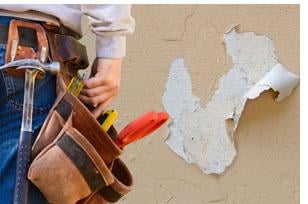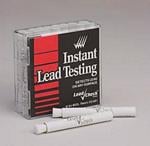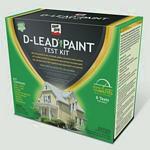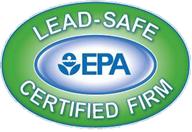EPA Lead-Safe Certified Firm Logo Use Guidelines

Guidelines for use of the Certified Firm Logo provided by EPA must be followed to avoid fines. Reading and understanding the following information can help make sure you are in compliance if you plan to use the firm logo on your vehicles, signage and or any marketing you do.
What is the Lead-Safe Certified Firm Logo?
The Lead-Safe Certified Firm Logo identifies a firm as certified under the Renovation, Repair, and Painting (RRP) Rule. The colors used to make the two-color logo are Pantone 362C (green) and Pantone 660C (blue). The font is Helvetica.
What are the guidelines for using the Logo?
The Logo must be reproduced so that all of its components are legible and includes your firm's certification number. The Logo must not be altered or distorted in any way.
You MAY --
- Use the Logo to identify your firm as an RRP-certified firm. Firms that are not RRP-certified may not use the Logo.
- Use the Logo in brochures, advertisements, Web sites, proposals, bills, signs, uniforms, vehicles and other materials promoting or identifying your firm.
- Use the Logo on documents or other materials in black and white or color (two-color or four-color versions are available).
You MAY NOT --
- Use the Logo in any manner that would imply EPA endorsement of a company, its products or services.
- Reduce the Logo to a size smaller than one inch wide by 0.687 inches in height.
- Allow a firm that is not RRP-certified (including your subcontractors) to use the Logo.
EPA will monitor the use of all Logos. If necessary, EPA will address failure to comply with these Logo Guidelines. To report a non-compliant use of the Logo, please contact EPA at 1-800-424-LEAD.
EPA will e-mail information regarding your custom Logo to the e-mail address listed on your firm certification application.
For further questions regarding your EPA Lead-Safe Certified firm Logo, please send an email to: EPARRPFirmLogo@battelle.org or send a fax to: (202) 566-0470. In your email/fax please include your EPA Firm Certification number (e.g., NAT-12345-1), Application ID (e.g., 12345), firm name, and firm mailing address.
EPA Lead-Safe Certified Firm Logo - Information for Training Providers
Accredited training providers may use the Logo on their site and marketing materials as long as it is used as a tool to guide renovators through the firm certification process (i.e., explain the difference between firm certification and individual training). Training providers may inform students that only certified firms will be provided a customized Logo exclusively for their use to advertise their businesses once their firm has been certified. Training providers may distribute the Logo only to principal instructors affiliated with the accredited provider, and only for the purpose of training as described above. Training providers may NOT distribute the Logo to unaffiliated entities. Upon request, EPA will provide to accredited training provider the Logo for their use. Requests can be made to the National Lead Information Center at 1-800-424-LEAD.
Principal instructors that advertise, provide training, and use the Logo must do so under the name of the accredited training provider for whom they work. They may also state that the organization that employs them, if different from the accredited training provider, is assisting with the training.
Information for Press and Marketing Entities
Press and other marketing entities may use the logo on their site and marketing materials provided it does not include a certification number. They may NOT:
- Distribute or provide a downloadable version of the logo
- Indicate association, endorsement or approval from EPA
- Imply lead-safe certification from EPA or any EPA-authorized state.
Upon request, EPA will provide the logo for use.
Note: The information shown above is from the EPA web site. EPA has already and may again revise these guidelines. Use this link to find the most recent info at the EPA web site.
 Posted signs: These must be posted on all sides of the work area to define the work area, must be in the primary language of occupants, must be posted before the beginning of the renovation, and must remain until cleaning verification is achieved.
Posted signs: These must be posted on all sides of the work area to define the work area, must be in the primary language of occupants, must be posted before the beginning of the renovation, and must remain until cleaning verification is achieved. Remove or cover furniture/objects: Remove (preferred) objects like furniture, rugs, window coverings; or cover them with plastic sheeting with all seams and edges taped.
Remove or cover furniture/objects: Remove (preferred) objects like furniture, rugs, window coverings; or cover them with plastic sheeting with all seams and edges taped. Cover duct opening: Close and cover all HVAC vents in the work area with taped down plastic sheeting or other impermeable materials (e.g., magnetic covers).
Cover duct opening: Close and cover all HVAC vents in the work area with taped down plastic sheeting or other impermeable materials (e.g., magnetic covers).
 Looking for accurate information about the EPA RRP rule?
Looking for accurate information about the EPA RRP rule? 


 No, the use of vertical containment is not required for interior jobs, but you can minimize the amount of floor containment needed by making use of vertical containment for interior projects. Floor containment measures may stop at the edge of the vertical barrier when using a vertical containment system consisting of impermeable barriers that extend from the floor to the ceiling and are tightly sealed at joints with the floor, ceiling and walls. One advantage of vertical containment in addition to the reduction of floor area to be covered is the potential reduction of the floor area and other areas that will need to be cleaned on completion of renovations
No, the use of vertical containment is not required for interior jobs, but you can minimize the amount of floor containment needed by making use of vertical containment for interior projects. Floor containment measures may stop at the edge of the vertical barrier when using a vertical containment system consisting of impermeable barriers that extend from the floor to the ceiling and are tightly sealed at joints with the floor, ceiling and walls. One advantage of vertical containment in addition to the reduction of floor area to be covered is the potential reduction of the floor area and other areas that will need to be cleaned on completion of renovations Yes, vertical containment, or an equivalent system of containing the work area, is required for exterior jobs where the property line is within 10 feet of the area of paint disturbance. In addition, vertical containment can also be used to minimize the amount of ground containment needed for a project. Ground containment measures may stop at the edge of the vertical barrier when using a vertical containment system.
Yes, vertical containment, or an equivalent system of containing the work area, is required for exterior jobs where the property line is within 10 feet of the area of paint disturbance. In addition, vertical containment can also be used to minimize the amount of ground containment needed for a project. Ground containment measures may stop at the edge of the vertical barrier when using a vertical containment system. Constructing vertical containment can also allow the contractor to create a sealed working space within a room where the dust can be completely contained to a limited and controlled area. The space created is referred to as a
Constructing vertical containment can also allow the contractor to create a sealed working space within a room where the dust can be completely contained to a limited and controlled area. The space created is referred to as a 
 Containment is required by the RRP Rule because it reduces the risk to you and residents. Following the work area setup requirements will protect you, your co-workers and residents by confining lead-contained dust and debris to a defined and demarcated area. Confining the lead is an important consideration in avoiding exposure. Reducing the risk to you and co-workers is also dependent upon use of personal protective equipment. Requirements for the personal protection of workers are established by OSHA and can be found in the OSHA document titled
Containment is required by the RRP Rule because it reduces the risk to you and residents. Following the work area setup requirements will protect you, your co-workers and residents by confining lead-contained dust and debris to a defined and demarcated area. Confining the lead is an important consideration in avoiding exposure. Reducing the risk to you and co-workers is also dependent upon use of personal protective equipment. Requirements for the personal protection of workers are established by OSHA and can be found in the OSHA document titled  Proper containment also facilitates efficient cleaning of the work area. The pre-work setup process is essential to keeping lead-contaminated dust confined to the work area where it can be easily cleaned. Proper containment of the work area helps to limit the area you need to clean after the job is complete. Knowing exactly where to clean is an important factor in saving time (and money) spent on cleanup.
Proper containment also facilitates efficient cleaning of the work area. The pre-work setup process is essential to keeping lead-contaminated dust confined to the work area where it can be easily cleaned. Proper containment of the work area helps to limit the area you need to clean after the job is complete. Knowing exactly where to clean is an important factor in saving time (and money) spent on cleanup.  Covering floors (or the ground) with plastic sheeting a minimum distance beyond the surfaces being renovated (6 feet for interior jobs and 10 feet for exterior jobs).
Covering floors (or the ground) with plastic sheeting a minimum distance beyond the surfaces being renovated (6 feet for interior jobs and 10 feet for exterior jobs). Property owners who renovate, repair, or prepare surfaces for painting in pre-1978 rental housing or space rented by child-care facilities must, before beginning work, provide tenants with a copy of EPA's lead hazard information pamphlet
Property owners who renovate, repair, or prepare surfaces for painting in pre-1978 rental housing or space rented by child-care facilities must, before beginning work, provide tenants with a copy of EPA's lead hazard information pamphlet  Beginning April 22, 2010, property owners who perform these projects in pre-1978 rental housing or space rented by child-care facilities
Beginning April 22, 2010, property owners who perform these projects in pre-1978 rental housing or space rented by child-care facilities  Hybrivet Systems, Inc. manufactures and distributes the
Hybrivet Systems, Inc. manufactures and distributes the  ESCA Tech, Inc. manufactures and distributes the
ESCA Tech, Inc. manufactures and distributes the  The RRP rule requires that dust and debris be controlled in the work area while working in homes built prior to 1978 unless all effected components of the renovation are properly tested and lead is not found. You can find information about the legal definition of lead paint and the accuracy of testing methods
The RRP rule requires that dust and debris be controlled in the work area while working in homes built prior to 1978 unless all effected components of the renovation are properly tested and lead is not found. You can find information about the legal definition of lead paint and the accuracy of testing methods  Required containment is similar for all jobs, but jobs that generate more dust and debris may require protection of larger areas. While the Rule does not require vertical containment, such systems may be helpful in limiting the size of the area affected by the work and may reduce the area that must be cleaned at the end of the job. Pre-engineered containment systems (purchased and home-made) are very helpful in cutting time spent on the job erecting containment and are easier to install than hanging plastic sheeting with tape. These systems also allow the contractor to create a sealed room within a room where the dust can be completely contained to a limited and controlled area.
Required containment is similar for all jobs, but jobs that generate more dust and debris may require protection of larger areas. While the Rule does not require vertical containment, such systems may be helpful in limiting the size of the area affected by the work and may reduce the area that must be cleaned at the end of the job. Pre-engineered containment systems (purchased and home-made) are very helpful in cutting time spent on the job erecting containment and are easier to install than hanging plastic sheeting with tape. These systems also allow the contractor to create a sealed room within a room where the dust can be completely contained to a limited and controlled area. 

 I suggest you check out the introduction section in the policy document. Although the policy document is intended to provide guidelines for EPA Enforcement staff, the document introduction also states:
I suggest you check out the introduction section in the policy document. Although the policy document is intended to provide guidelines for EPA Enforcement staff, the document introduction also states: 
 One way to think about this might be to relate it to eating fish. The government often says that if you fish in certain bodies of polluted water, you can safely eat up to so many of the fish you catch without any health concerns. If the government says you can eat up to 3 fish a year, how safe would you feel eating even one fish? Using this analogy, how safe might the owner feel having renovations done if there is any lead present at all at their property?
One way to think about this might be to relate it to eating fish. The government often says that if you fish in certain bodies of polluted water, you can safely eat up to so many of the fish you catch without any health concerns. If the government says you can eat up to 3 fish a year, how safe would you feel eating even one fish? Using this analogy, how safe might the owner feel having renovations done if there is any lead present at all at their property?


